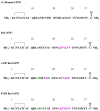The ability of rodent islet amyloid polypeptide to inhibit amyloid formation by human islet amyloid polypeptide has important implications for the mechanism of amyloid formation and the design of inhibitors
- PMID: 20028124
- PMCID: PMC2882292
- DOI: 10.1021/bi901751b
The ability of rodent islet amyloid polypeptide to inhibit amyloid formation by human islet amyloid polypeptide has important implications for the mechanism of amyloid formation and the design of inhibitors
Abstract
Islet amyloid polypeptide (IAPP) is a 37-residue polypeptide hormone that is responsible for islet amyloid formation in type II diabetes. Human IAPP is extremely amyloidogenic, while rat IAPP and mouse IAPP do not form amyloid in vitro or in vivo. Rat IAPP and mouse IAPP have identical primary sequences, but differ from the human polypeptide at six positions, five of which are localized between residues 20 and 29. The ability of rat IAPP to inhibit amyloid formation by human IAPP was tested, and the rat peptide was found to be an effective inhibitor. Thioflavin-T fluorescence-monitored kinetic experiments, transmission electron microscopy, and circular dichroism showed that rat IAPP lengthened the lag phase for amyloid formation by human IAPP, slowed the growth rate, reduced the amount of amyloid fibrils produced in a dose-dependent manner, and altered the morphology of the fibrils. The inhibition of human IAPP amyloid formation by rat IAPP can be rationalized by a model that postulates formation of an early helical intermediate during amyloid formation where the helical region is localized to the N-terminal region of IAPP. The model predicts that proline mutations in the putative helical region should lead to ineffective inhibitors as should mutations that alter the peptide-peptide interaction interface. We confirmed this by testing the ability of A13P and F15D point mutants of rat IAPP to inhibit amyloid formation by human IAPP. Both these mutants were noticeably less effective inhibitors than wild-type rat IAPP. The implications for inhibitor design are discussed.
Figures








Similar articles
-
Islet amyloid polypeptide: pinpointing amino acid residues linked to amyloid fibril formation.Proc Natl Acad Sci U S A. 1990 Jul;87(13):5036-40. doi: 10.1073/pnas.87.13.5036. Proc Natl Acad Sci U S A. 1990. PMID: 2195544 Free PMC article.
-
Destabilization of human IAPP amyloid fibrils by proline mutations outside of the putative amyloidogenic domain: is there a critical amyloidogenic domain in human IAPP?J Mol Biol. 2006 Jan 13;355(2):274-81. doi: 10.1016/j.jmb.2005.10.052. Epub 2005 Nov 8. J Mol Biol. 2006. PMID: 16303136
-
Mutational analysis of the ability of resveratrol to inhibit amyloid formation by islet amyloid polypeptide: critical evaluation of the importance of aromatic-inhibitor and histidine-inhibitor interactions.Biochemistry. 2015 Jan 27;54(3):666-76. doi: 10.1021/bi501016r. Epub 2015 Jan 15. Biochemistry. 2015. PMID: 25531836 Free PMC article.
-
Molecular physiology of the islet amyloid polypeptide (IAPP)/amylin gene in man, rat, and transgenic mice.J Cell Biochem. 1994;55 Suppl:39-53. doi: 10.1002/jcb.240550006. J Cell Biochem. 1994. PMID: 7929617 Review.
-
Islet amyloid and type 2 diabetes: from molecular misfolding to islet pathophysiology.Biochim Biophys Acta. 2001 Nov 29;1537(3):179-203. doi: 10.1016/s0925-4439(01)00078-3. Biochim Biophys Acta. 2001. PMID: 11731221 Review.
Cited by
-
Aggregation of islet amyloid polypeptide: from physical chemistry to cell biology.Curr Opin Struct Biol. 2013 Feb;23(1):82-9. doi: 10.1016/j.sbi.2012.11.003. Epub 2012 Dec 22. Curr Opin Struct Biol. 2013. PMID: 23266002 Free PMC article. Review.
-
Structural similarities and differences between amyloidogenic and non-amyloidogenic islet amyloid polypeptide (IAPP) sequences and implications for the dual physiological and pathological activities of these peptides.PLoS Comput Biol. 2013;9(8):e1003211. doi: 10.1371/journal.pcbi.1003211. Epub 2013 Aug 29. PLoS Comput Biol. 2013. PMID: 24009497 Free PMC article.
-
Understanding co-polymerization in amyloid formation by direct observation of mixed oligomers.Chem Sci. 2017 Jul 1;8(7):5030-5040. doi: 10.1039/c7sc00620a. Epub 2017 May 9. Chem Sci. 2017. PMID: 28970890 Free PMC article.
-
Designed hairpin peptides interfere with amyloidogenesis pathways: fibril formation and cytotoxicity inhibition, interception of the preamyloid state.Biochemistry. 2011 Sep 27;50(38):8202-12. doi: 10.1021/bi200760h. Epub 2011 Aug 30. Biochemistry. 2011. PMID: 21848289 Free PMC article.
-
Pre-structured hydrophobic peptide β-strands: A universal amyloid trap?Arch Biochem Biophys. 2019 Mar 30;664:51-61. doi: 10.1016/j.abb.2019.01.032. Epub 2019 Jan 29. Arch Biochem Biophys. 2019. PMID: 30707943 Free PMC article. Review.
References
-
- Chiti F, Dobson CM. Protein misfolding, functional amyloid, and human disease. Annu Rev Biochem. 2006;75:333–366. - PubMed
-
- Sipe JD. Amyloidosis. Crit Rev Cl Lab Sci. 1994;31:325–354. - PubMed
-
- Selkoe DJ. Cell biology of protein misfolding: The examples of Alzheimer's and Parkinson's diseases. Nat Cell Biol. 2004;6:1054–1061. - PubMed
Publication types
MeSH terms
Substances
Grants and funding
LinkOut - more resources
Full Text Sources

